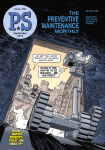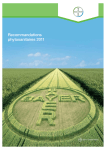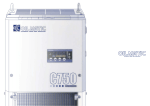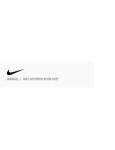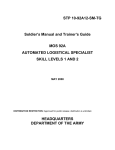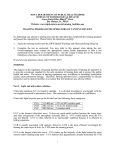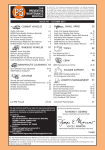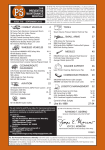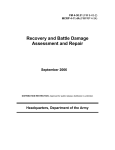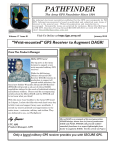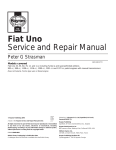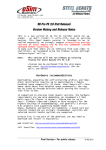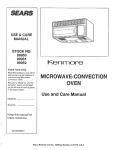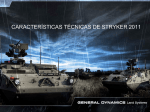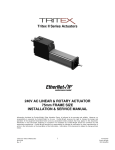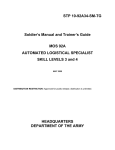Download See page 50 for winter safety tips!
Transcript
Issue 733 TB 43-PS-733 Approved for Public Release; Distribution is Unlimited December 2013 this cold weather gear sure keeps us warm! wish we’d had that back in 1951! See page 50 for winter safety tips! CSM Corner… Take Care of COmMo EQUiPMeNT iS ViTAL TO THE SUCcEsS OF A MisSiON. KeEP iT COMMUNiCATiNG WiTH GOoD PReVENtiVE mAiNTEnaNcE! YOUR Critical Link: CSM kenis j. dent, CE-LCMC Radios Would anyone seriously consider going on a resupply mission or a combat patrol without radios, blue force tracker, or boomerang targeting antennas? Of course not! Radio communications are vital to the success of a mission. The information you can gather from communications capabilities is critical to having situational awareness and remaining in contact with Command and Control—ultimately to keep you as safe as possible as you execute the mission. But to preserve this precious capability, we must remain vigilant in protecting our equipment through preventive maintenance. Electronics are sensitive pieces of equipment and require protection from corrosion and static discharge. Adopt maintenance habits to mitigate the risk of electronic systems failing when you need them most. Be careful! The electrical systems we work with introduce high voltages, energy and heat. These properties carry the potential for serious shocks and burns to operators and maintenance personnel, both military and civilian. Read your technical manuals and bulletins. The civilians here at CECOM are here to assist. They continually update technical publications so Soldiers in the ield have the information they need to perform preventive maintenance checks and services. Be aware of the warning signs concerning broken insulation, frayed wires, loose and missing bonded connections between platforms. Use your technical publications like you should and be safe! Remember, radios, and all communications equipment, are the critical link to your success on the battleield. Take care of your situational awareness resources! 733 00-01.indd 1-2 ISSUE 733 DECEMBER 2013 COMBAT VEHICLES NATO Slave Cable Parts, Maintenance Going Beyond PMCS Charts CARC Spray Primer Touch-Up Stryker Heater Caution Grease Fitting Cap NSN M88-Series Recovery Vehicle Roadwheel Nuts AVLB Scissoring Cable Rotation TACTICAL VEHICLES PLS Cold Weather Pubs, Ether Use PLS, HEMTT LHS E-CHU Slide Locks Up-Armored HMMWV Door Insulation MRAP MaxxPro Dash Go Light Covers Fire Extinguisher Inspection Ground Guide Tips Lead-Acid Battery Instructions CCE/MHE SUSV Grille Covers M9 ACE Driver’s Hatch Lubing Reminder D7G Tractor Air Filters DEUCE Blade Exercising AVIATION AH-64A/D Towing Tips UH-60A/L, HH-60M Piston and Strut Cleaning HGU-56/P Helmet Painting SATS Moving Mystery Solved The Night Before A PM Christmas TB 43-PS-733, The Preventive Maintenance Monthly, is an official publication of the Department of the Army, providing information for all Soldiers assigned to combat and combat support units and all Soldiers with unit maintenance and supply duties. All information published has been reviewed and approved by the agency responsible for the equipment, publication or policy discussed. Application of the information is optional with the user. Masculine pronouns may refer to both genders. The use of product or company names does not constitute endorsement of those products, services or companies by the U.S. Army. The use of non-DoD hyperlinks, along with their content, does not constitute endorsement by DoD or DA. Neither DoD nor DA exercises any editorial control over, and cannot vouch for, content on non-DoD websites. SMALL ARMS 2 2-3 4-5 6 7 7 8 9 10 10-11 12 13 14 15 16-17 17 18 18 19 20-21 21 22 22 23-24 24 25-26 27-34 35 AN/PEQ-16B for the M16, M4 and M249 35 M16-Series Rifle, M4/M4A1 Carbine Cleaning Kit 36 FMTV Machine Gun Mount Extension 37 CROWS Hand Receipt Online 37 MK 19 UPWS Name Change 37 M9 Pistol Crack Inspection 38-39 Arms Room Dehumidifier 40-41 42 CBRN M40/M42-Series Mask PM Tips M41 PATS Storage and Shipping Tips 42-43 44-45 46 COMMO/ELECTRONICS 46-48 49 49 49 CR123A Counterfeit Batteries 5-, 10-, 15-kW TQG POCs for K1 Contactor Sanitation Team FM Generator Set Training 50 SOLDIER SUPPORT 50-52 Winter Safety Facts, Injury Prevention LOGISTICS MANAGEMENT 53 MMIS Moves to LIW MSD V2 Still Needed for EMS-2 IETMs MTS, JCR-LOG Systems Tracking PS Magazine Article Submission UTAP Offers Tactical Vehicle Driver’s Course Knowledge Center Adds Content CSS VSAT/CAISI Pocket Guide STAMIS/LIS Guide Now Available Connie’s Post Scripts You are invited to send PS your ideas for improving maintenance procedures, questions on maintenance and supply problems and questions or comments on material published in PS. Just write to: MSG Half-Mast PS, the Preventive Maintenance Monthly USAMC LOGSA (AMXLS-GP) Bldg. 3303 Redstone Arsenal, AL 35898 Or email to: [email protected] or [email protected] Internet address: https://www.logsa.army.mil/psmag/pshome.cfm 53 54-55 56-57 57 58 59 59 59 60-61 By order of the Secretary of the Army: RAYMOND T. ODIERNO General, United States Army Chief of Staff Official: GERALD B. O’KEEFE Administrative Assistant to the Secretary of the Army 1330201 PS, The Preventive Maintenance Monthly (ISSN 0475-2953) is published monthly by the Department of the Army, Redstone Arsenal, AL 35898. Periodical postage is paid at the Huntsville, AL post office and at additional mailing offices. Postmaster: Send address changes to PS, The Preventive Maintenance Monthly, USAMC LOGSA (AMXLS-GP), Bldg. 3303, Redstone Arsenal, AL 35898. 11/11/13 3:09 PM NATO Slave Cable… Give Cable maintenance a Charge! say, Pally. How’s about givin’ me a jump? my slave cable’s busted. can’t. my cable’s busted, toO! Slave cables are easy to use. And they can sure come in handy for getting your vehicle back into action when it has a dead battery. Take a close look at the end connector for bare or exposed wires where insulation has pulled back from the connector housing. Item Cable w/o end connectors Cable w/ end connectors End connector Connector adapter (allows either end of cable to fit two-hole receptacles) Then keep reading to learn how to make repairs… NSNNSN UI 6150-00-398-6527 6150-01-022-6004 5935-00-567-0128 5935-00-322-8959 Connector Cover Fix Water can get inside the connector and corrode the cables if the connector inserts are loose and the cover won’t seal tight. Fix that problem like this: 1. Remove the cover plate. 2. Remove loose inserts by threading a screw into the insert and gently wiggling the insert until it comes out the body of the connector. 3. Fill each hole about halfway with silicone adhesive caulk, NSN 8040-00-865-8991, or a similar caulk meeting MIL-A46106B specs. Remove loose inserts and fill holes halfway with caulk If your slave cable has bare wires, have your mechanic do this: 1. Make sure the cable isn’t connected to any power source. 2. Remove the connector’s back plate, then disconnect the cable from the connector. 3. Cut off the terminal lugs. Strip back just enough insulation to put on new terminal lugs, NSN 5940-00-115-5004. 4. Reconnect the cables to the connector. Make sure the positive lead (+) is reconnected to the center post and the Remove negative lead (-) is reconnected to the cover negative cup of the connector. plate 5. Reassemble the connector. 4. Press the insert back into the hole, making sure it’s lush with the surface of the connector. Wipe away any excess caulk. Let the caulk cure for an hour or two so the inserts stay in place. 5. Run a thin bead of silicone adhesive caulk around the connector lip and screw down the cover. Wipe off any caulk that oozes out. Again, let the caulk cure for an hour or two before using the cable. To get back into the connector the next time, remove the screws and use a sharp knife to carefully cut through the caulk. PS 733 733 02-03.indd 1-2 Item But slave cables, just like every other piece of gear, NeEd maintenance to make sure they’re ready to help you out of a jam. Stop the Shock Make sure you don’t get the shock of your life from bare wires when hooking up your slave cable. if your slave cable is missing any parts, here’s a list of replacements. 3 DEC 13 11/6/13 1:25 PM Combat Vehicles… but I did all your Go Go Beyond Beyond The Book Book The for Good Good for PM PM PMCS checks. Just because you’ve gone line by line through the PMCS tables of your vehicle’s -10 TM, doesn’t mean the job’s done. …see… …smell… 733 04-05.indd 1-2 you gotta do more to make sure I’m running right! Weld points require careful inspection. A failing weld may show movement, gaps, corrosion and laked or missing paint. Because a lot of items don’t have specific procedures called out, doing good PM means more than just going by PMCS charts. YOu neEd to… Check bolts, clamps, nuts and screws regularly for looseness. You can spot loose fasteners by looking for chipped paint, bare metal or rust around the heads. Inspect electrical connections and cables. Look for broken connectors and worn or cut cables. Check the hose, clamps and hose ittings. Look for abrasions, seepage or leaks. Feel for leaks in areas you can’t see. Take a sniff, too. Some luids have a distinct odor. …hear… …and touch… Catches, locks and hinges should operate smoothly. Look for metal fatigue, wear and other damage. Listen for squeals that indicate rust. …to uncover potential problems that might make your vehicle NMC. Let your mechanic know right away if you find any of these problems. PS 733 going beyond the PMCs tables will ensure your vehicle is ready to safely complete any mission. 5 DEC 13 11/6/13 1:24 PM Spray Primer Makes Touch-Up Easy Combat Vehicles… Gotta put some primer on you before we touch up your paint. There’s an easier way, y’know! Stryker… Stop Heater Meltdowns Cold it’s so cold my feet and hands are like ice cubes! No problem! We can use the nbc heater in the back of the Stryker to thaw out! you do that and my heater will have to be replaced! Stryker crewmen looking to escape the cold desert night sometimes try to keep When it’s time for some touch-up work on your vehicle’s paint job, reach for MIL-PRF-53022 Type V primer. That’s the oficial primer designed to go underneath WD CARC paint. Aerosol version It’s now available as an aerosol, which makes it a lot of MIL-PRF-53022 easier to use than the cans of liquid primer that have primer now to be applied with a brush or roller. And it’s chromate available free, so it’s better for you and the environment. Because it’s an aerosol, you don’t have to spend time measuring or mixing the primer. And clean-up is a snap because you don’t need any special containers for disposal. Get a box of six 8 1/2-oz cans with NSN 8010-01610-7329, while NSN 8010-01-610-7330 gets you six 13 1/2-oz cans. Instructions for use come with the primer. Be sure to check out TB 43-0242, WD CARC Spot Painting, before you get started. That’ll tell you everything you need to know about how to touch up your vehicle. PS 733 733 06-07.indd 1-2 6 DEC 13 warm any way they can. And one method many Soldiers use to beat the cold is sticking the hose of the NBC/M3 heater inside their uniforms and turning the heater up to full blast. Those heaters weren’t designed to be used like that. The unit will overheat and the plastic plugs at the ends of the heater will melt. Once that happens, your unit will have to order a whole new heater, NSN 4240-00-807-6856, because replacement plugs aren’t available. That sets your unit back about $250. Check out the NBC Ventilating System Operation or Chemical Defense System Operation section Plastic plugs will melt if NBC heater is misused of your -10 TM for the right way to use your NBC/M3 heater. Combat Vehicles… A Tip of the Cap for Grease Fittings D irt, mud and sand can make a real mess of your combat vehicle’s grease ittings. Even worse, lubing dirty grease ittings just forces contaminants in along with the grease. And that damages bearings and other components. You can keep ittings clean by covering them with protective caps, NSN 4730-00-2898148. Order plenty so you always have them on hand when you’re doing PMCS. Just remember that even capped ittings need to be wiped off before lubing to make sure the grease isn’t contaminated. 10/28/13 5:50 PM M88-Series Recovery Vehicle… Torque Nuts RIGHT to Keep ‘Em TIGHT B LE B WO BBL E O W BBL E WO BB L E WO BB L E WO 8 lemme guess… you installed the scissoring cables with the strands rotated the wrong way? I folLowed the TM! Rotate Just Any Ol’ Way! BB L E Loose roadwheel nuts are all but inevitable, considering the weight and pressure they’re under. Just because they’re torqued in place doesn’t mean they’ll stay that way. And when even one nut loosens, that increases the pressure on the rest. Pretty soon, there’s a chain reaction of loose nuts, wobbly road-wheels and snapped studs. That can cause a thrown track and a big headache! Spot loose nuts before they cause any trouble. Look for shiny spots around the lat washer under the roadwheel nut. Replace missing nuts with NSN 531001-064-3910 and lat washers with NSN 5310-00-809-9514. Retorque loose nuts to 320-350 lb-ft for the M88A1 and 350-400 lb-ft for the M88A2. Loose nut can damage roadwheel 733 08-09.indd 1-2 Don’t Oh, Man! somebody shoulda tightened my roadwheel nuts! Mechanics, one loose roadwheel nut on your M88series recovery vehicle could mean calling someone to tow YOU back to the motor pool! PS 733 WO AVLB… DEC 13 Dear Half-Mast, I’m confused about the right way to rotate the scissoring cable strands on AVLBs. Page 2-31 in TM 5-5420-203-14 (Jun 91, w/Ch 2, Jun 97) shows the right-side rotation as counterclockwise and the left-side as clockwise. But Page 3-21 shows the right-side rotation as clockwise and the leftside as counterclockwise. What’s the right rotation for the cable strands? SPC D.B. Dear Specialist D.B., You’re right. The information in TM 5-5420-203-14 is confusing. And if the cables aren’t rotated the right way, they can ride up on the grooved rims of the cable lays and damage the quadrant. You might even end up dropping the bridge! A Detail A Detail B B Cable rotation clockwise Cable rotation counterclockwise Until the TM is corrected, note that Page 3-21 shows the proper rotation, which is clockwise for the right side and counterclockwise for the left side. PS 733 9 DEC 13 10/28/13 5:52 PM if you want me to go out in that freezing weather, you have to protect me against the cold! PLS… Make {sigH} Cold Later… here’s your favorite blanket! well, I do feel warmer, but extra PM is what I had in mind! Weather Care count If you’re stationed in Alaska or any other place with arctic conditions, you’re probably no stranger to operating vehicles in extreme cold. But in that type of environment, your unit’s M1074, M1074A1, M1075, and M1075A1 Palletized Loading System (PLS) trucks will need extra prep and more maintenance to operate well. Ether and Engines Winter Resources Pay special attention to these other pubs that can help keep your vehicles up and running in winter weather: • • • • FM 9-207, Operations and Maintenance of Ordnance Materiel in Cold Weather (Jul 13) ATTP 3-97.11, Cold Region Operations (Jan 11) TC 21-305-20, Manual for the Wheeled Vehicle Operator (Jul 09) TB 750-651, Use of Antifreeze Multi-Engine Type Cleaning Compounds and Test Kit in Engine Cooling Systems (Sep 06) • TM 750-254, Cooling Systems: Tactical Vehicles (Mar 72, w/Ch 2, Apr 73) Keep these references in your maintenance shop. Just make sure you have the latest version of the TM and these other pubs. DA PAM 25-30 can help you with that. See: http://armypubs.army.mil/2530.html 733 10-11.indd 1-2 That’s right, Bonnie! we’re good to have around! Why? Cold weather puts more stress on vehicles, creating issues that don’t exist in normal temperatures. So follow the guidance in TM 9-2320-364-14&P for your M1074 and M1075 PLS and TM 9-2320-319-13&P for your M1074A1 and M1075A1 PLS. Then you can properly operate and maintain your trucks. you said it, buddy! hear, hear! The engines in PLS trucks have built-in ether starting aids. They use measured amounts of ether to help start your trucks in very cold weather. Use only the approved procedures shown in the TM for ether usage. External spray cans of ether are not authorized for use on any PLS trucks. If you think it’s no big deal to spray the ether anyway, maybe this will change your mind. Ether has a higher and hotter rate of burn than JP8 and diesel. Spraying external ether can damage your PLS truck’s engine, causing your vehicle to stop instead of start! Spraying ether into engines will crack pistons, fracture cylinder sleeves, bend connecting rods and ruin engine cylinder heads. This can lead to permanent damage and your vehicle will be NMC. That’s not what you want. So remember, whenever your PLS truck won’t start, do this: • Follow the troubleshooting guidance in the Operator’s TM. • If that doesn’t help, call your mechanic to find out what’s wrong. PS 733 11 Don’t use spray can ether! DEC 13 10/28/13 5:50 PM PLS, HEMTT LHS… To Lock or Not to Lock Searching for Door insulation? Up-Armored HMMWVs… E-CHU Slide Locks There’s a right time and a wrong time to lock my E-CHU slide locks. FOAM PADDiNG… FOAM PADDiNG… AH! THERE iT iS. NOW TO FiGURE OUT WHiCH ONE I NEED! JUST WAiT ‘TiL YOU GET TO the fastener AiSLE! O perators, Step 2 in WP 0008-7 of TB 9-3950-253-13&P (Jul 09, w/Ch 1, Jun 12) says to push the locking handle on the enhanced-container handling unit (E-CHU) toward the container to secure the slide lock when transporting a container. But when transferring a container to an M1076/M1076A1 trailer, there’s no safe way to reach and unlock the slides so you can detach the E-CHU. The ladders in your PLS and HEMTT BIIs aren’t tall enough, so you have to lower the container to the ground, undo the slide locks, and then place the container on the trailer. The slides should be locked only when you’re raising a partially submerged container or picking up a tipped-over lift frame like it says in WP 0009 of the TB. Any other time, leave the slide locks alone. Make a note until the TB is corrected. Do not use slide locks unless raising partially submerged container or picking up tippedover lift frame PS 733 733 12-13.indd 1-2 12 Dear Half-Mast, My unit needs thermal insulation kits, or foam padding, for our M1151A1 HMMWV’s front and rear doors. I’ve searched, but can’t seem to find any NSNs. Can you help us? MSG M.C. Dear Master Sergeant M.C., I sure can! Item HMMWV Models TACOM LCMC M1151A1, M1152A1, has a new, ireM1165A1 and M1167 resistant door M1151A1, M1152A1, foam that is M1165A1 and M1167 precut for doors M1151A1, M1165A1 on the following and M1167 HMMWV M1151A1, M1165A1 models: and M1167 NSN Item UI NSN 2510- Left-hand front door 01-606-1450 Right-hand front door 01-606-2365 Left-hand rear door 01-606-2339 Right-hand rear door 01-606-2357 These are the only NSNs available now. So for doors on HMMWV models other than those listed, you’ll need to order the foam in bulk, NSN 2510-01-575-4233. Then cut it to it your doors. DEC 13 PS 733 13 DEC 13 11/6/13 1:24 PM MRAP MaxxPro Dash… what to do about melted MELTED cover Oh, man! I forgot to remove your spotlight cover when I turned it on last night! Now the cover’s Operators OK’d to Inspect Fire Extinguishers Tactical Vehicles… melTed! I’m done with my operator PMCS, but who inspects the fire extinguisher? you do, sergeant! Don’t worry about it! Turns out I don’t even NEed a cover! Dear Half-Mast, I have a question about the go light on my MaxxPro Dash. We forgot to remove the cover before powering up the go light and partially melted it. I’ve looked everywhere I can think of but can’t seem to find an NSN for a replacement cover. Is there an NSN or do we need to order a new go light to get the cover? SSG M.J.P. Dear Sergeant M.J.P., I’ve got good news and bad news. The bad news is that there is no NSN for the cover. The good news is that you won’t need to order a new go light. Turns out the light wasn’t supposed to have a cover to begin with! The manufacturer accidentally included the covers when the irst round of go lights were distributed. Ordering a Toss and don’t replace new go light will now bring the light damaged cover without the cover. So you can toss that damaged cover. It’s not needed. PS 733 733 14-15.indd 1-2 14 DEC 13 Dear Editor, A lot of email traffic has been generated over who is qualified to routinely inspect fire extinguishers on Army vehicles. The answer is the operator doing PMCS. The safety engineers at TACOM LCMC’s safety office weighed in with the following statement: A Soldier does not have to be certified or licensed to do the PMCS inspections. They are NOT allowed to repair or refill the bottles if an issue is found and the vehicle is to be considered NMC until the bottle/AFES system is brought back to ready. If the fire department or other office has a requirement to check all fire extinguishers on base, including those contained in vehicles, by certified personnel, this is above and beyond the vehicle’s requirement. PMCS should still be done per the intervals called out in the TM. Please help us tell the field that operators should inspect their vehicle’s AFES. Editor’s note: Your Ron Rowland Action/Security Officer, TWV comments should extinguish TACOM LCMC those emails, Mr. Rowland. Warren, MI PS 733 15 DEC 13 10/28/13 5:50 PM Safety… GROUND GUIDED whew! goOd to see you there, sergeant! I sure prefer it when someone points out my path in tight spots like this. Remember, safe, efficient vehicle operations and personnel safety depend on clear, accurate communication between Soldiers. I’ll do my best to keep you from goin’ off course. To review standard visual signals, see FM 21-60, Visual Signals, at: http://armypubs.army.mil/doctrine/ DR_pubs/DR_a/pdf/fm21_60.pdf Find more ground guide materials in the U.S. Army Combat Readiness/Safety Center Driver’s Training Toolbox. Visit: https://safety.army.mil/drivertrainingtoolbox When in Doubt, Go with the Vehicle TM Lead-Acid Batteries… we can help inform you about your truck’s batterY. A rmy equipment is often large and awkward to move. Safely maneuvering large equipment, especially in tight spaces, requires properly trained and positioned ground guides. However, simply using ground guides isn’t enough. Good crew coordination is critical. It only takes a split second for a driver to lose sight of a ground guide, or for a ground guide to make a mistake that can result in major equipment damage or worse, an injury or death. Here are some tips for safe ground guiding: • Everyone should know this is basic visual signals the dayused in communicating time signal for ‘slow with drivers, including down.’ lashlight signals. • Position front ground guides to the left front of vehicles. Ground guides must never walk directly in a vehicle’s path. • When two ground guides are used, they must maintain visual contact with each other at all times. The front ground guide must stop the vehicle if he loses sight of the rear ground guide. • Drivers must immediately stop if they lose sight of a ground guide or don’t understand a signal. • Ground guides, not vehicle commanders, are in charge of moving vehicles. When a vehicle is under a ground guide’s control, the only command the vehicle commander should issue to the driver is “stop.” 733 16-17.indd 1-2 but if we disagree, you should listen to ME! Dear Editor, We’ve been told about an issue with TM 9-6140-200-13, Operator and Field Maintenance for Automotive Lead-Acid Storage Batteries, (May 11). The TM includes some general procedures that may differ from the information found in vehicle tech manuals. The solution is to go with the guidance in the vehicle TM. We recommend that users write this statement under “How to Use This Manual” on Page ix of TM 9-6140-200-13: TM 9-6140-200-13 does not supersede the Vehicular TMs. You should see this in a future TM update. Boyd Dial Energy Storage Team Editor’s note: The battery guidance Battery Lab Manager in the vehicle’s TM trumps the battery US Army TARDEC TM. Got it, and thanks, Mr. Dial. PS 733 17 DEC 13 10/29/13 11:06 AM SUSV… We’d better get the grille covers in place before this SUSV goes into storage. if you’ll get the front cover, I’ll take care of the rear one! M9 ACE… A Little Lube Saves Your Noggin’ Hey, operator! {OoF!} you’re one lucky guy. this little grease gun just saved your noggin’! Know When to Use Grille Covers D rivers, make sure you use the SUSV’s grille covers during the off-season (after the thaw and before the irst freeze). Without the covers, mechanical and electrical components in the engine compartment can rust and corrode. Here’s what to do if you know your vehicle won’t be used for more than a week: • Turn the key to STOP. • Do PMCS. • Remove drain plugs and store them in the front door pocket. • Install front… Operators, keep this PM tip in mind ‘cause it’s a real noggin’ saver! Without lube, condensation gets into the hatch hinge assembly’s internal spring, causing it to rust. The spring continues to weaken until it inally breaks. Then the hatch cover can fall on your head! There are two grease ittings Lube that lube the assembly’s internal here… spring. They’re shown in Note 16 of WP 0076-25 in TM 5-2350-262-10 (Jun 12). Give …and each itting four or ive pumps of here GMD quarterly. …and rear grille covers. • Disconnect the battery’s ground cable. Then add a tag to the vehicle’s keys as a reminder that the battery is disconnected. • Remove the front engine hood. Unfortunately, GMD is missing from the Expendable and Durable items List in WP 0082 of TM 5-2350-262-10. If you’re parking your SUSV for a week or less: Until it can be added, order from this list… • Turn the key to STOP. • Install the front and rear grille covers. Never operate the vehicle with grille covers installed. Power train components will overheat and can cause a ire. If your grille covers are missing, order one for the front with NSN 2540-01-3091078. NSN 2540-01-309-1079 gets the rear cover. PS 733 733 18-19.indd 1-2 18 DEC 13 PS 733 19 Size 14-oz cartridge 1.75-lb can 6.5-lb can 35-lb can NSN NSN 9150- UI 00-935-4018 00-754-2595 00-223-4004 00-965-2003 DEC 13 10/28/13 5:58 PM Keep Air Filter Clean and Sealed Make the Seal Tight D7G Tractor… With the ilter elements installed, make sure the canister lid closes completely. That lid needs a tight seal to keep out the dirt and sand that can ruin your dozer’s turbocharger and engine. The lid has a recessed lip with a raised mark on its outer cover. Make sure this area points toward the front of the vehicle. That way the primary ilter element its tight against the lid with a good seal. DEUCE… Operators, keep a close eye on the air cleaner indicator right next to your dozer’s air ilter element canister. If the indicator moves to red, it’s cleaning time. Open the canister and pull out the primary air ilter. Use an air hose from a nearby tactical vehicle to blow low-pressure air (30 psi or less) from the inside out. Never bang the ilter on a rock or hard surface like the dozer’s track. That just damages the ilter. You should replace the primary air ilter element once a year or after six cleanings, whichever comes irst. When the dozer’s secondary ilter Air ilter indicator showing red? becomes clogged, have your unit mechanic replace it. How do you tell if it’s clogged? After installing a clean or new primary ilter element, watch the air cleaner indicator. If it moves into the red zone when you start your dozer, the secondary ilter’s clogged. Black exhaust smoke is another sign of a clogged ilter. 733 20-21.indd 1-2 Exercise Keps Joints Moving The lower pivot pin on the DEUCE’s blade will rust in place when the vehicle sits too long in the motor pool without exercise. A clean air filter keeps me running strong! PS 733 Raised mark points towards vehicle front 20 DEC 13 and That can damage my front-end hydraulics! Then you can’t elevate or lower the blade until the rust breaks free. it can’t be said enough— exercise your excavator! Operate all the hydraulics at least once a week. That way rust won’t freeze the pin in place. A shot of dry-film lubricant spray, NSN 9150-01-2602534, will also help keep the rust at bay. Give pivot pin a shot of dry-ilm lubricant 10/28/13 5:51 PM AH-64A/D… The Towing Hook Up what?! WHaT’s Wrong?? you didn’t have my quick-release pin in place when you started towing me. now my tail lock actuator is sheared! do you know how much that hurts!? UH-60A/L, HH-60M… You’re all cleaned and ready to go. Oh, I love the smell of clean in the morning! Take Care of Pistons and Struts aww, man… I’m goin’ on Sick caLl! M echanics, proper towing procedures for your AH-64 are important if you want to avoid tail wheel damage. Too often, the quick release pin either isn’t in place before towing or it gets missed when preparing your aircraft for the tow bar. If that happens, you’ll shear the tail wheel lock actuator. Then your bird is out of commission. To avoid damaging the tail wheel, always press the lock handle down irst and then fully insert the quick release pin. This allows the wheel to pivot when towed. If the handle is left up, the wheel is locked and if you tow the aircraft, you’ll break the lock pin. Also, make sure the lock handle doesn’t pop back up before inserting the pin. When the handle is down and the pin is in, hook up the tow bar and you’re ready to go. Before towing, make sure lock handle is down Never tow without quick release pin M echanics, your Black Hawk pistons are moving parts that need attention to protect their seals. Make a habit of wiping down all aircraft pistons with a clean dry cloth before and after each light and after you wash the aircraft. If you don’t lube them after you wash, calcium deposits will damage the seals. Do what it says in TM 1-1520-237-23 series and your unit SOP. For the M-model, follow the good words in TM 1-1520-28023&P. The following parts all have seals: the pitch, roll and yaw piston; the primary servo pistons in the hydraulic deck; the main rotor damper pistons; the main landing gear struts; the tail landing gear struts; the tail rotor servo piston and the stabilator actuator. Quick release pin here Just don’t forget the ground guides and brake rider when towing. They will help you keep aircraft blades from running into hangar doors and other aircraft. PS 733 733 22-23.indd 1-2 22 DEC 13 Clean pistons… …and struts to protect seals 11/6/13 1:24 PM Remember though, when you inspect the hydraulic deck pistons, some seepage is allowed, like it says in WP 0691 00 of TM 1-1520-23723-4. Follow the leakage inspection criteria for the M-model like it says in TM 1-1520-280-23&P. If the piston surfaces aren’t cleaned regularly, dirt and grime build up and eat away the seals, causing leaks and blown seals. If leaks happen and seals blow, cleaning is no longer an option. You’ll have to remove other parts of the aircraft to repair more damage from blown seals. AGSE… You can avoid bigger maintenance problems by just wiping down pistons during required intervals. Watch Out For Moving SATS watch out! comin’ through! ALSE… New Green Paint for HGU-56/P Helmet hey, Jonesy! I think I missed my calling… I coulda been the next picassO! whadaya think? what the…!? Smitty, Only ALSE techs like me are authorized to paint helmets! Hey! I put you in park and your parking brake is on! why are you moving!? the headshed just put out an aviation message on this. I dunno! you need to remove a diode to keep the sats from moving while in park. I’m glad I got the new green paint so I can paint over your handiwork! ALSE techs, Page 41 of 693 (Aug 10) told you about the color change to foliage green for the aircrew integrated helmet system (AIHS), HGU-56/P helmet. Good news! There’s now a new foliage green paint, NSN 8010-01-576-8919, available for spot painting the helmet. Make a note until all the details about the new paint are added in the next update to TM 1-1680-377-13&P-1. For all helmet painting information, check out WP 0058 00 in TM 1-1680-377-13&P. PS 733 733 24-25.indd 1-2 24 DEC 13 Mechanics, if your standard aircraft towing system (SATS), NSN 1740-01-575- 5662, suddenly moves while you’re doing PMCS, a faulty, shorted diode is most likely the culprit. When the gear selector is in park with the parking brake applied and the reverse work light turned on, the SATS can shift into reverse and begin moving. That’s not supposed to happen! PS 733 25 11/6/13 1:24 PM To keep the SATS from moving when it shouldn’t, you’ll need to remove the problem diode. Follow these steps… 1. Loosen the two clamps on the bottom of the dash panel. 5. Remove the diode assembly at both 1 /4-in terminals. 109 66 6. Tape over or place heat shrink tubing on the terminal ends. was the night before Christmas, and throughout Camp Lore, Not a Soldier was stirring, there was barely a snore. 2. Open the panel to expose the dash wiring harness. 3. Cut the wire ties as necessary. 4. Locate the diode assembly on wires 66 and 109. 733 26-27.indd 1-2 7. Install wire ties as necessary. 8. Close the panel and reinstall the clamps on the dash cover. Removal of the diode does not deadline the SATS. The only function lost is the reverse work lights won’t come on automatically when the vehicle is in reverse. But the backup alarm will function normally and the reverse work lights can still be manually activated. For more information, check out the safety action message AGSE-13ASAM-01. You ind it on the Joint Technical Data Integration (JTDI) website: https://upw.jtdi.mil After removing the faulty reverse light diode assembly, check out the permanent ix with installation instructions for the reverse light relay assembly in aviation maintenance action message (AMAM) AGSE-13-AMAM-01, issued by the original equipment manufacturer (OEM). PS Magazine will publish a full article on the permanent ix in an upcoming issue. This ix will appear in the next change to TM 1-1740-221-13&P. he stockings were hung on the motor pool walls, in hopes they’d be filled by ol’ Santa Claus. PS 733 he operators and mechanics were snug in their racks, While dreams of PM had them completely relaxed. 27 nd me, the 1st Sergeant, had just climbed into bed. I was closing my eyes as I lay down my head. DEC 13 11/6/13 1:24 PM hen out in the motor pool there came a great noise, I hopped straight out of bed, barely keeping my poise. Over to the window I ran really fast, And pushed it wide open so I could see what had passed. t the reins was a driver with a big square jaw, I knew right away it must be Half-Mast Santa Claus! Faster than lightning all his reindeer did fly, And he shouted their names as they moved ‘cross the sky! he sodium lights spread a dim yellow glow, On the snow-covered trucks in the lot down below. My eyes popped wide open as on that winter frontier, Flew a big red sleigh pulled by eight feisty reindeer. ow, Dudley! Now, Smedley! Now, Percy and Joe! On, Seymour! On, Crusty! On Dexter and Moe! PS 733 733 28-29.indd 1-2 28 o the top of the motor pool, quick as can be! I’ve got TMs to deliver for these Soldiers to see!” DEC 13 11/6/13 1:24 PM e was dressed in green camo from his head to his toes, I was shocked when I saw him and immediately froze. ith a crack of his whip and a mighty “Ho, ho!” Half-Mast Santa up the building did go. Up on the rooftop they arrived with a crash, His overstuffed sleigh filled with a PM mishmash. is glasses, they sparkled! His grin rather knowing, His cheeks were quite red; I guess it’d been snowing. e was a perfect picture of classic Americana, few seconds later, I heard steps up on top, And then, right behind me, I heard a loud plop! I turned around quickly, and what did I see? Why, HalfMast Santa Claus just as real as can be! e had a huge bag filled with all kinds of stuff, ike TMs and grease guns—he’d brought quite enough. xcept his chin was clean-shaven. No beard for this Santa! ell-mannered and neat, and polite as you please, The smile on his face quickly put me at ease. hen dropping his pack to the floor with a sigh, He stretched out his back and looked me in the eye. PS 733 733 30-31.indd 1-2 30 DEC 13 11/6/13 1:24 PM ll these gifts went in stockings or right on the floor, Then he went back to his pack and dug out some more! it took quite a while before his bag was deflated, But the emptier it got, the more he seemed elated! ith finger to lips, and a “Shhh!” as his plea, He dug through his pack as he dropped to one knee. Lube orders, multimeters, grease guns and pliers, When I thought he was done, he pulled out some tires! inished at last and pack now quite bare, He turned from his work and climbed up the stair. Before he could vanish, he gave me a wink, PS 733 733 32-33.indd 1-2 nd then he was gone, before I could blink. 33 DEC 13 11/6/13 1:24 PM Small Arms… e jumped in his sleigh and I looked back outside, As they took to the sky like a ship at high tide. But I heard him call out as he sped through the night, AN/PEQ-16B AN/PEQ-16B is is the the Way Way to to Go Go sorry, guys! I”m replacing you both on the M16, M4 and M249 automatic gun. Not so fast! yeah! We’ll still be needed for the M240, M2, MK 19 and M249 machine guns. shoo, shoo. When it’s time to replace your M16/M4’s AN/PEQ-2A, AN/PEQ-15 or -15A aiming laser, or the weapons mounted light (WML)… remember this cHristMas to KeEp PM Burning Bright! PS 733 733 34-35.indd 1-2 …you have a new choice. you can order the AN/PEQ-16B with NSN 5855-01-582-1584. The AN/PEQ-16B combines an aiming laser with a WML. That means you won’t need as many remote cables and batteries and you’ll have a lighter load. But remember that the AN/PEQ-16B can be used only on the M4/M4A1 carbine, M16-series rile and the M249 when it’s used as an automatic rile. It can’t be used on the M249, M240, M2 or MK 19 machine guns. For those, order the AN/PEQ-15 or -15A with NSN 5855-01-537-6000. That NSN will bring either the -15 or -15A. If you have any questions about sights, contact TACOM’s Dennis Timmons at DSN 786-1347, (586) 282-1347, or email: [email protected] or Anthony Smith at DSN 786-1350, (586) 282-1350, or email: [email protected] 35 DEC 13 11/6/13 1:24 PM M16-Series Rile, M4/M4A1 Carbine… Machine Gun Mounts… I saved more than $400 by ordering your cleaning kit parts Is There a your ring mount haS the pintle mounted so close to you that it’s difficult to mount anything other than the M249 machine gun with the collapsible stock. Disarm FMTV Mount Problem individually! Chea pe r Cleaning Kit? tell me there’s a solution! you are one smart and thrifty gal! Last year the Army started fielding an adjustable arm assembly that extends the weapon out 9 inches. Order the adjustable arm with NSN 1090-01568-5052. there is a solution. Dear Half-Mast, We read in PS that the NSN for the new M16/M4 cleaning kit is NSN 1005-01-562-7393. But when you check the AMDF, the kit’s cost is $481. Is there a cheaper kit? CPL B.M. Dear Corporal B.M., No, there is no cheaper cleaning kit available, at least through the Army. You will save lots of money by ordering the parts of the cleaning kit individually, though: • Maintenance equipment case, NSN 8465-00-781-9564, $4.60 (This is listed in the AAL of TM 9-1005-319-10. All of the other items are listed under Expendable and Durable Items List.) • Cleaning rod handle section, NSN 1005-01-113-0321, $2.09 • Cleaning rod section, NSN 1005-00-050-6357, 25 per box and three required for one cleaning rod, $18.60 That comes to a grand total • Swab holder, NSN 1005-00-937-2250, $.78 of $32.04. That’s a savings of • Bore brush, NSN 1005-00-903-1296, $.42 $448.96 for each cleaning kit. • Chamber brush, NSN 1005-00-999-1435, $.78 • Toothbrush, NSN 1005-00-494-6602, $.46 • Cleaning brush, NSN 7920-00-205-2401, $1.91 • CLP, ½-oz bottle, NSN 9150-01-102-1473, $2.40 PS 733 733 36-37.indd 1-2 36 DEC 13 CROWS Hand Receipt Online If you need the hand receipt for CROWS II, you can download it at either the LOTTIS site https://utap.army.mil or LOGSA site https://www.logsa.army.mil/etms. The LOTTIS site also includes a POC list of the CROWS support team. At the LOTTIS site, go to ARMY TAB, ill in keyword “CROWS”, and then hit CLICK HERE TO GET DETAILS. At the LOGSA ETM site, ill in TM 9-1090-219-10-HR for the pubs number search. MK 19 UPWS Name Change The MK 19 up gun weapon station (UPWS) has had a name and LIN change. Its nomenclature is now MK 19 machine gun MOD 4 and its LIN has changed from Z01612 to M05019. Make the changes in your property book. PS 733 37 DEC 13 11/6/13 1:23 PM Crack Check M9 Pistol… Crack Down on Cracks... and Other Stuff uh-oh! I think I seE a crack! may be time for you to retire, old buddy. • the locking block along the front and rear of the locking lugs. That’s where cracks and chips usually appear. • the barrel in the area around the locking block • the inside of the slide where the locking lugs sit • the receiver rails where the locking block sits in the receiver • around the magazine catch r cracks Check fo as: are in these …in barrel around locking block… Check for cracks in locking block… …in slide around locking lugs… …in receiver rails where locking block sits… …and around magazine catch Cracks usually mean you need a new pistol. Tell your armorer if you spot any. Safety Lever If the safety lever is bent, don’t try to bend it back. That just weakens the lever or snaps it off. Support needs to replace the lever. Report bent safety lever. Don’t try to bend it back I knew I just wasn’t My Old Self! A n M9 pistol that is ired frequently will develop cracks eventually. There’s nothing you can do to stop cracks, but you can spot them before they crack up your M9. PS 733 733 38-39.indd 1-2 Clean Rails Make a point when cleaning to wipe off the receiver and slide rails. If the rails become gritty with sand, the backand-forth action of the slide wears out the bearing surfaces and soon you’ve got iring problems. Be sure to wipe off rails When you do PMCS, do this crack check. it takes just a minute. Trigger Bar Spring First, wipe any oil off the pistol. Oil can hide cracks. 38 DEC 13 Be careful when cleaning inside the magazine well. Many trigger bar springs are lost each year during cleaning. The spring is under lots of tension. If you nudge it—ZING—it’s gone. No spring means no iring. Keep cleaning tools away from the spring and make sure the spring is still in place when you’re through cleaning. 11/6/13 1:23 PM Small Arms… dry up humidit y aww… I’m just not big enough for this job. there’s no way you can ever suck up all my moisture! waa-bbw ha! ha ha-ha! take a rest, little buddy. hope you’re thirsty! I’m taking over! threat P! HOO SHH arg!!! not so fast, mr. Humidity! Dear Half-Mast, Our Reserve unit was moved to a consolidated Reserve center where our weapons are now stored in a large arms room. I cleaned and lubed my M16 just like the TM says and then stored it in the arms room. When I checked it again two months later, I found RUST. When I checked the humidity level inside the arms room, it read 51 percent. Is there any official guidance on how much humidity is acceptable? SGT K.S. PS 733 733 40-41.indd 1-2 Dear Sergeant K.S., There is no Army reg on humidity in an arms room, but humidity certainly should be way below 51 percent–35 to 45 percent would be more like it. Your problem is likely that the dehumidiier in your arms room is too small. Most home dehumidiiers hold only 15 pints, which is too small for many arms rooms, especially consolidated ones. Get a 30- to 60-pint dehumidiier. Industrial supply houses like McMaster-Carr or Grainger and large home supply outlets have a wide selection. You might also want to consider buying one with an integral drain so that water can be run directly to a building drain. 40 DEC 13 If your commander doesn’t want to spend the money on a big dehumidiier, point out how much it costs to replace a single M2 machine gun because of corrosion–$12,685. You can buy many dehumidiiers for much less. Remember that dehumidiiers start to lose their effectiveness above 95°F. So keep the room temperature below that. Dehumidiiers should be positioned on the loor since moist air settles. Circulation helps ight humidity, too, so running a fan is a good idea, especially if it blows into corners. Another good investment is a humidity meter. You can get a good one for $25. The meter lets you directly monitor the humidity. Shoot for 35 to 45 percent to prevent corrosion. PS 733 41 Of course, you also need to follow the PMCS in the technical manuals… …especially the parts on lubing and checking stored weapons at least every 90 days for corrosion. 10/29/13 10:31 AM M40/M42-Series Masks… Follow these tips so we can both breathe easier! Dear Editor, You will definitely breathe easier in your M40/M42 mask if you remember these tips: Train, train, train. We see Soldiers who are just handed a now we are going to train, train, train mask and really don’t have any idea until you know me on how to put it together or wear inside and out! it. Sergeant’s Time is an excellent time for CBRN specialists to go over mask basics with units. TM 3-4240-346-10 and -23&P are excellent tools for training. If you’re a new CBRN specialist and don’t have much training yourself, most major posts have some sort of CBRN school you can go through to prepare you for your new job. Remember the M40 I can canister can be on either go right side of the mask. That helps or left left-handed Soldiers when they’re with my firing their weapons. canister. talented I’m When you sanitize a mask or like that! issue a mask to a new Soldier, replace the outlet, inlet and two nosecup disks, the internal drink tube, and the head harness. They wear out over time, which makes it difficult for the mask to function. These items aren’t expensive, so replacing them is a good, cheap way to keep the mask breathing right. 733 42-43.indd 1-2 Make sure you learn how to use M41 PATS. That is the best way to ensure your Soldiers have masks that properly fit. In too many CBRN rooms, PATS isn’t being used because CBRN specialists aren’t sure how to use it. Also make sure PATS is calibrated. It won’t do you any good if it gives false results. Consider where you let’s see… today is will be operating when s’posed to be bright ‘n’ choosing which outserts sunny…so I think I’ll go with my tinted outserts. to use. If you’re going to be in bright sunshine most of the time, use the tinted outserts. If it’s going to be cloudy or at night, use the clear outserts. Once you have the mask on, it’s difficult to change the outserts. Forget the faceform for storage. You no longer need to install the plastic insert in the mask when it’s going to be stored for a long time. The mask will hold its shape without the insert if it’s stored like the TM tells you to. Just remember to store the mask with the head harness straps pulled over the front of the mask. Also ensure the mask is stored with the outserts installed so the primary lenses don’t get scratched. Don’t crank the headharness straps hey! take it tight. New Soldiers often easy. you’re going to give do this, which results in the yourself Mother of All Headaches. If a terrible your scalp tingles after you headache if you tighten tighten the straps, they’re my straps so probably too tight. Loosen tight! the straps and place a finger under the clip and buckle. Adjust the strap until the clips and buckle feel snug. Do this for all the straps. Put on your mask Putting chin first. That helps it fit mask on better. chin first When you do your gives a mask PMCS, check all better fit the straps for elasticity. If they’ve lost their snap, they won’t do a good job of holding the mask in place. Get a new head harness. SFC Peter Carona 100th Chem Bn JBLM, WA PS 733 Editor’s note: You’ve unmasked some great mask ideas, Sergeant. Thanks for sharing. 43 DEC 13 10/29/13 10:51 AM M41 PATS… I flunked because you forgot my storage and shipping rules. Thanks a lot! How to Store and Ship Short Term Storage For short-term storage, it’s critical you remove all alcohol from PATS. if the alcohol cartridge is left inside the cartridge cavity, alcohol could flood the optics and your PATS is out of business. Cover the cartridge cavity with the storage cap. That prevents dirt from getting inside the PATS. Always recap alcohol containers immediately to prevent them from absorbing moisture, which weakens the alcohol’s purity. Keep the storage cap and alcohol cartridge clean. Always set them down with their ends standing up so they don’t pick up dirt. 733 44-45.indd 1-2 44 Your M41 protection assessment test system (PATS) will flunk the test for testing masks if you don’t remember a few rules for storage and shipment… Shipment or Long Term Storage Remove the alcohol cartridge and store it in the alcohol ill capsule. PS 733 Oops! DEC 13 if the PATS is going to be shipped or is going to be stored for longer than 60 days, follow the short-term storage rules with these additions… Remove and properly dispose of all alcohol inside Let sponge the alcohol ill capsule. Let and the sponge and capsule capsule dry dry completely before completely storage. Otherwise, you could have a ire hazard. Remove and properly dispose of the used alcohol wick inside the alcohol cartridge. Install a new, dry wick in the alcohol cartridge. Install new, dry wick See WP 15 in TM 3-4240349-12&P for instructions. Remove all alcohol bottles from the PATS carrying case and store them in an authorized storage area in accordance with your local SOP. If PATS is being shipped, order alcohol when you arrive at your new location. Remove all batteries from the PATS and its carrying case and store them in an authorized storage area. Batteries should be either shipped separately or new ones ordered at the new location. Never ship the PATS without its carrying case and accessories. The case is specially designed to protect PATS. 10/29/13 10:35 AM Don’t Be CR123A Batteries… Do you use CR123A 3V lithium non-rechargeable batteries, NSN 6135-01-351-1131, in any of your night sights, LED flashlights, headlamps or cameras? if so… Fooled by …listen up! Fakes These knockoffs may even have labels and logos similar to those on name-brand batteries. Authentic CR123A counterfeit CR123A FLASHLIGHTS FLASHLIGHTS But make no mistake. The counterfeit CR123As are substandard. bonk! CAUTION: RISK OF FIRE. EXP CAUTION: RISK OF FIRE. EXP BURNS. DO NOT RECHARGE BURNS. DO NOT RECHARGE Date No date HEAT ABOVE 212 F (100 C) OR HEAT ABOVE 212 F (100 C) OR stamp stamp DO NOT MIX WITH USED OR OTHER DO NOT MIX WITH USED OR OTHER TYPES. KEEP AWAY FROM CHILDREN TYPES. KEEP AWAY FROM CHILDREN 10 SUREFIRE, L.L.C. SUREFIRE, L.L.C. Correct Fountain Valley, California 92708 Fountain Valley, Colifornia 92708 spelling Misspelling 800-828-8809 714-545-9444 800-828-8809 (California) (Colifornia) 714-545-9444 ahh… doy. Already these batteries have injured people and damaged equipment. Counterfeit CR123A batteries are being sold to the public. what do you mean by ‘counterfeit’? let me show you. They’re poorly designed and manufactured. K! Y OIN They pose health and safety risks because they can overheat and… The counterfeits usually enter the American market from overseas. They’re often sold at a reduced price on the internet and at swap meets, gun shows, and electronics and technical shows. FFER! SPECIAL O ING !! S!! V INGS How can you spot a counterfeit CR123A? Look for… AV SA IVEE S SIV SS M AS MA LY!!! TODAY ON By counterfeit we mean batteries that look similar in size, shape and color to many name-brand batteries. 733 46-47.indd 1-2 PS 733 47 …catch fire or explode when used, transported or stored. • label misspellings. • missing label information. • blurred fonts. • altered logos or seals. • altered or substandard packaging. • label dimensions different from those of an authentic CR123A. DEC 13 10/29/13 10:35 AM 5-, 10-, 15-kW TQGs… if you suspect you have counterfeit CR123As, remove them from the equipment, keep them away from other batteries, and return them or dispose of them according to your local SOP. Order authentic CR123As by NSN through the Army supply system. That way you can be sure you’re getting good batteries. Using CR123As • Don’t mix and match fresh and partially used batteries. They have different capacities. Capacity is the amount When using of energy a battery can deliver in a single discharge authentic (normally expressed in ampere hours). A difference CR123As… in capacities can cause a stronger battery to charge a weaker one. That can make the weaker battery overheat, fail, leak, vent, catch ire or burst. • Don’t use CR123As from different manufacturers. They may have different chemical properties. That can lead to a difference in capacities. • Make sure all batteries used in a piece of equipment have a date code within 6 months of one another. For the complete story, see CECOM Ground Precautionary Action (GPA) Message 2013-006, Operational: Counterfeit Lithium Non-Rechargeable Batteries, CR123A Batteries. it’s on the CECOM Directorate for Safety website… Additional POC for K1 Contactor The article listed two POCs from CECOM LCMC who can help you get the replacement. On Pages 50-51 of PS 726 (May 13), we discussed how to get a free replacement for a faulty K1 contactor in 5-, 10and 15-kW tactical quiet generators (TQG). Now there are three POCs… Brian Sohosky DSN 648-6989, (443) 395-6989 [email protected] Scottee Welsh DSN 648-6950, (443) 395-6950 [email protected] Michael Barney DSN 648-4758, (443) 395-4758 [email protected] Sanitation Team FM Over the course of the US Army’s 236-year history, disease and non-battle injuries have caused more casualties than battleield wounds. That’s an excellent reason to form a unit ield sanitation team if you don’t already have one. Start by reading FM 4-25.12, Unit Field Sanitation Team (Jan 02). The FM discusses: • team development and duties. • heat and cold injuries. • water and food sanitation. • toxic chemical hazards. • waste disposal.. • noise hazards. • pest control. The FM also has: • a team training course. • a list of supplies needed for ield sanitation. Paras 1-7 and 2-29 of AR 40-5, Preventive Medicine (May 07), require every company-sized Army unit to have a ield sanitation team. https://cecomsafety.apg.army.mil/sfmessages2/ Generator Set Training Do you need help maintaining your generator sets? Project Manager, Mobile Electric Power (PM-MEP), has developed a series of online training classes to help maintainers keep their generators in top shape. The PM-MEP generator training site is on Land War Net at: https://lwn.army.mil/training/-/wiki/main/mobile+electric+power You’ll need an AKO login and password to access the site. PS 733 733 48-49.indd 1-2 49 DEC 13 10/29/13 10:33 AM don’t be a Winter Safety… Armies have lost battles and campaigns because of brutally cold winter weather. casualty CASUALTY of THE OF the COLD cold The Army has learned the hard lessons of history. Today, serious cold-weather injuries are less common. But they’ll stay that way only if you understand the threat. Leaders and Soldiers must remain alert for symptoms of cold injuries. The Cold Facts in the winter of 1812, Napoleon lost 250,000 soldiers during the long, freezing retreat from Moscow. Cold weather exposure can lead to frostbite and hypothermia. Both are dangerous conditions. Frostbite is the freezing of body tissue caused by exposure to freezing temperatures. Frostbite usually occurs on the face, ears, ingers and toes. Hypothermia is the lowering of core body temperature. Hypothermia occurs when the body gets cold and loses heat faster than the body can make it. Frostbite Here are the symptoms of frostbite… On the Eastern Front in World War II, 100,000 German soldiers suffered frostbite during December 1941 and January 1942. Fifteen thousand of them needed amputations. And here’s the first aid for tissue suffering from frostbite… During the Korean War, cold injuries accounted for nearly 10 percent of all U.S. Army casualties. PS 733 733 50-51.indd 1-2 DEC 13 PS 733 • Numbness • A tingling or burning sensation • Red skin, later turning to a waxy yellow (grayish in darkskinned Soldiers) • Tissue that feels wooden to the touch Frostsbite can cripple and maim • Warm the affected area at room temperature, with direct body heat from another Soldier, or with warm water (98-104°F). • Do not thaw frozen tissue if there’s a chance it might freeze again. Refreezing can further damage tissue. • Do not expose frozen tissue to intense heat (open lames, stove tops, steam, heat packs). • Do not rub or massage. You might damage the skin. • Do not wet the tissue or rub it with snow or ice. • Seek medical treatment as soon as possible. 51 DEC 13 11/6/13 1:23 PM Hypothermia Here are the symptoms of hypothermia… Logistics Management… • Cold sensation, goose bumps, numbness • Shivering, lack of coordination, sluggishness MMIS Moves to LIW Hypothermia occurs when your body loses heat faster than it can make heat The Modification Management information System (MMIS) must now be accessed through the Logistics Support Activity’s (LOGSA) Logistics Information Warehouse (LIW) portal. Existing MMIS accounts did not transfer to the LIW version. If you were a prior MMIS user but do not have an LIW account, apply for LIW basic access at: https://liw.logsa.army.mil/ All LIW users have read-only access to MMIS through an LIW basic account. If you need to enter conirmation and completion info on maintenance work orders (MWOs), safety of use messages (SOUMS), maintenance advisory messages (MAMs), and/or ground precautionary actions (GPAs), you must also submit an LIW SAR for the “MMIS Supervisor” role and include proper justiication. If you need “MMIS LCMC” role access to update materiel change numbers (MCNs) on MWOs, submit a SAR with justiication. For speciic MMIS questions, email: [email protected] • Violent shivering, dificulty speaking, mental confusion, stumbling • Muscle stiffness, slurred speech, blurred vision • Unconsciousness, irregular heartbeat And here’s the first aid for victims of hypothermia… • • • • Move the victim to a dry, warm place. Strip off wet or frozen clothing. Warm with blankets, dry clothing or your own body heat. Apply heat to the skin (radiant heat, hot water bottles, electric blankets) ONLY if the victim has stopped shivering. Check the skin often to prevent burns. • Seek medical treatment as soon as possible. To learn more about cold-weather injuries, read TB MED 508, Prevention and Management of ColdWeather injuries. if you need general help or have access problems, contact LOGSA’s help desk at: Toll Free: 1-866-211-3367 CONUS: DSN 645-7716 OCONUS: DSN 312-645-7716 commercial: 256-955-7716, or email: [email protected] You’ll find it on the U.S. Army Publishing Directorate website: http://www.apd.army.mil From the home page, expand the Publications tab and click on Administrative Publications. On the next screen, click on Medical Admin Publications. On the next screen, scroll down to TB MED 508. PS 733 733 52-53.indd 1-2 52 it is no longer a stand-alone application. PS 733 53 DEC 13 10/29/13 10:42 AM Publications… Keep MSD V2 Around for EMS-2 IETMs You can’t go, buddy! I - I can’t open these EMS-2 IETMs! So long, folks. My work’s aLl done and my ride’s here! and My Soldier needs ‘em to do maintenance! So some of you may need to keep your old MSD V2 for awhile! WAiT! WAiT! M echanics, keep your Maintenance Support Device Version 2 (MSD V2) handy. You’ll need it if you still use Electronic Maintenance System-2 (EMS-2) interactive electronic technical manuals (IETMs) or software loader veriier (SLV) to maintain equipment. You can’t view EMS-2 IETMs or use the SLV on the newer MSD V3. That’s because EMS-2 IETMs and the SLV don’t work on any computer with a Windows 7 or newer operating system (OS). That includes the MSD V3. EMS-2 IETMs and the SLV work only on computers with an OS like Windows Vista or earlier. That includes the MSD V2. Bradley, M1-series tank, Direct Support Electrical Systems Test Set (DSESTS), Stryker, Long Range Advanced Scout Surveillance System (LRAS3) and Paladin systems use SLV software to change the irmware in their on-board modules. So if you maintain any of these systems with SLV, keep your MSD V2. if you already turned in the old MSD V2, you can get another one. The TMDE headshed has authorized it. NSNs for MSD V2 6625-01-536-1764 (MSD V2 kit) 6625-01-493-8968 (MSD V2 kit with ICE kit) 6625-01-562-9904 (MSD V2 kit) NSNs for MSD V3 6625-01-599-9556 (MSD V3 kit with SWICE Spiral 3 kit) 6625-01-598-2187 (MSD V3 kit with SWICE Spiral 2 kit) 6625-01-599-9498 (MSD V3 kit) 6625-01-592-6732 (MSD V3 kit) All EMS-2 IETMs are slated to be converted to Electronic Maintenance System—Next Generation (EMS NG) by March 2015, but until then they can only be viewed on the MSD V2. 54 733 54-55.indd 1-2 just like Oil and Vinegar don’t mix, The EMS NG viewer can’t run EMS-2 IETMs and SLV. DEC 13 M1-series tank, Bradley, Paladin, LRAS3 hang on to your and DSESTS’ SLV software are slated to MSD V2… I need it! become compatible with Windows 7 OS by March 2014 and Stryker by March 2015. The EMS-2 viewing software has not been supported or updated since December 2011. If your MSD V2 has not been updated since you received it, contact TMDE to request updated software. The current versions of the EMS NG Viewer and Autonomous Diagnostics Manager (ADM) (v2.1.5) are designed to run on the MSD V3 (Windows 7). The MSD and other test hardware such as internal combustion engine (ICE) kits and EMS NG software suites are tested for compatibility and brought up-to-speed as technology evolves. The EMS NG Viewer and ADM can operate on several operating systems and personal computers, but the primary computer for any EMS IETM is the MSD. For questions about hardware like the MSD or your ICE kit, contact the MSD help desk at 1-877-564-1137 or submit a help ticket to the TMDE headshed at: https://tmde-register.us.army.mil/TMDE_Register/ MSD_Home/MSD_POCs_Intro.aspx For questions on EMS software products such as EMS-2, EMS NG or the ADM, contact the EMS help desk by phone at 1-877-445-1780, or email: [email protected] Or submit a customer incident report through the EMS web-based ticketing system, Service Now, at: http://www.EMS-Helpdesk.com PS 733 55 DEC 13 11/8/13 10:38 AM Logistics Management… I love your enthusiasm, but I think there’s an easier way! cloE, I’m all set to start tracking those MTS and JCR-Log accountability systems! sniff Record MTS and JCR-Log Systems RIGHT! Also, many JCR-Log systems were ielded using the MTS Magnus NSN as the system NSN. PBOs, check that your unit’s JCR-Log system is recorded by the correct end item NSN. Here are the primary components associated with the MTS and JCR-Log systems, including part numbers… AN/UYQ-90A(V)2 AN/UYQ-90A(V)3 AN/UYQ-90(V)2 AN/UYQ-90(V)3 PS 733 733 56-57.indd 1-2 JCR-Log/ MRT mobile unit JCR-Log/ MRT control station MTS mobile unit MTS control station sniff NSN 7010- Transceiver NSNNSN Transceiver UI PN 01-603-7650 7035-01609-4139 CMDC-SM5I1GNGR C78851 01-603-7648 7035-01609-4139 CMDC-SM5I1GNGR C18278 01-476-0935 C78851 01-476-0934 5895-01543-2565 5895-01543-2565 CMDC-SM3I1GNGR CMDC-SM3I1GNGR C18278 56 MRT display unit N/A MT-2011 transceiver 5895-01-543-2565 Magnus keyboard N/A Port expander N/A Computer, digital N/A Transit case N/A DEC 13 PN NSN F100189 20500018 501801 CMDC-SM3-I1GNGR MT 2010-1 F100190 502358-1 MTS-CS-05A MTS-CS-01 NBT 140-TS06 1753-0004 30-15697-200 30-15697-300 JCR-Log MRT Mobile Unit and Control Station Primary Components Nomenclature (JCR-Log) accountability systems should be tracked by their MT-2012 transceiver serial numbers. This changes the way many systems are tracked in Property Book Unit Supply Enhanced (PBUSE). It standardizes the method of recording MTS and JCR-Log systems across the Army. The goal is consistency and Army-wide asset visibility. There are currently four variants that Property Book Oficers (PBOs) must ensure are recorded correctly in PBUSE. The following table covers each type: Common LIN Item Name NSN Item Nomenclature sniff A ll Movement Tracking System (MTS) and Joint Capabilities Release–Logistics Type Designation MTS Magnus System Mobile Unit and Control Station Primary Components MRT display unit Solid state hard drive Transit case MRT keyboard data MT-2012 RSI transceiver NSN Item 7021-01-609-4244 7025-01-609-4245 7045-01-611-9299 7025-01-609-4251 7035-01-609-4139 PN NSN 9800-55800-0010 9800-53000-2413 1753-2004 9800-48669-0000 CMDC-SM5-I1GNGR Questions? Contact Sharon Conroy at DSN 648-1757, 443-3951757, or email: [email protected] PS Magazine… Yep! It’s Just That Easy Folks sometimes tell us they hesitate to submit articles because they assume it’s hard to get anything published in PS. Not true! We’re always open to submissions. Want guidelines? Check them out here… https://www.logsa.army.mil/psmag/archives/PS2012/715/715-56-57.pdf 10/29/13 10:47 AM UTAP Offers Tactical Vehicle Driver’s Course Training… I’D LiKE SOME DRiVER’S TRAiNiNG, PLEASE. WOULD’JA LiKE SOME FRiES WiTH THAT? Supply Management… These updates to the CSDP & Property Accountability Knowledge Center have me pumped! Knowledge Center Beefs Up Content he Property Accountability and Command Supply Discipline Program (CSDP) Knowledge Center on AKO recently made some major updates. We irst told you about the site on Page 57 of PS 723 (Feb 13): https://www.logsa.army.mil/psmag/archives/PS2013/723/723-57.pdf Since then, the site has added tabs for commanders, units, S4 operations, property book and mentorship. You can view videos and ind CSDP certiicate-producing courses. You can also upload documents like tactics, techniques and procedures or SOPs to the site to share with others. Check it out! Visit the CSDP and Property Accountability Knowledge Center at: https://www.us.army.mil/suite/page/670916 For more information about the Knowledge Center or to ask CSDP questions, choose Ask the EXPERT on the site or email: [email protected] T L ooking for driver’s training that won’t bust a hole in your unit’s budget? The Unit Training Assistance Program (UTAP) at TACOM LCMC offers an advanced tactical vehicle driver’s course online. You can ind the course in the Library of TACOM Training Information Site (LOTTIS). Get your CAC and go to: https://utap.army.mil Once you’ve logged in, click on Tactical Vehicle Drivers Course (Advanced) at the top left of the page. Click one simple button to ind driver’s training at UTAP CSS VSAT/CAISI Pocket Guide The Combined Arms Support Command (CASCOM) offers a small, pocket-sized guide on two Army sustainment tools, the Combat Service Support Very Small Aperture Terminal (CSS VSAT) and Combat Service Support Automated Information Systems Interface (CAISI). The guide shows how these tools work with GCSS-Army and lists POCs for support. Download the guide at the milSuite forum: https://www.milsuite.mil/book/docs/DOC-102046 Click here! Say Cheese: Guide IDs STAMIS/LIS The training is 40 hours. There are 10 modules that include PowerPoint slides and a training support plan in PDF. The complete package includes videos, course critique, inal exam and course certiicate. There are 27 documents and three videos available for download. If you have any problems inding or downloading course content, email: [email protected] A handy STAMIS/LIS guide for users at all levels is available from the Software Engineering Center-Lee Tactical Logistics Directorate. The Logistics STAMIS Identification Guide includes many photos, plus handy details like LINs and NSNs, making it a great resource for any unit to have on hand. It’s also an excellent identiication tool for scheduled hand receipt inventories. Download a pdf copy at: https://www.milsuite.mil/book/message/397579 PS 733 PS 733 733 58-59.indd 1-2 58 DEC 13 59 DEC 13 10/29/13 10:37 AM Connie's Post Scripts M93 GPFU Configuration Changes The M93 gas particulate ilter unit (GPFU) has been modiied. The M48A1 ilter, NSN 4240-01363-1311, is no longer part of the M93 and now must be ordered separately. The new M93 GPFU NSN without the M48A1 ilter is NSN 4240-01-615-1867. By removing the M48A1, the M93’s shelf life is extended. Fire Extinguisher for 5kW Generator Automotive Battery Handling PPE Change The safety goggles, NSN 4240-00-269-7912, that are listed as Item 10 in WP 0034-2 of TM 9-6140-200-13 have been replaced with NSN 4240-01-460-1841. These replacement personal protective equipment (PPE) goggles it over most prescription glasses so you can see and stay safe while pulling maintenance. Make this change to the PPE listed in your unit’s battery TMs. STRETCHY STRAPS FOR TRUCK TIRE CHAINS Even after tightening your vehicle’s tire chains by hand to avoid gouging, they still might be a little too loose. Correct that by snugging down the tire chains with a stretchy strap. Choose what you need from these options: Length (in inches) Strength (in inches) NSN NSN 5340UI 15 21 31 20-30 26-42 36-42 01-029-9084 01-231-6015 01-029-9085 PS 733 733 60-61.indd 1-2 The 5-kW generator’s 5-lb ire extinguisher is listed as NSN 4210-00-361-6921 in the Additional Authorization List (AAL) of TM 9-6115-659-13&P (Jan 10). That’s wrong. The correct NSN is 4210-01-361-6921. Make a note until the TM is updated. Attention PBOs: Watch Unit Transfers As brigade combat teams begin reorganizing, the following information is important for property book oficers (PBOs) to remember. To do a proper unit transfer in PBUSE, you must be sure that all DODAACs/transactions are sterilized and/or closed. Hung up dueins (due-ins that have no status at a supply support activity [SSA], but still show status in PBUSE) and open items in suspense iles are major reasons why unit transfers fail. If you are not running transactions on blast with the SSA to update your box, then it will result in multiple versions of iles. To ensure a clean unit transfer, follow the instructions in Section 7 of the PBUSE End User Manual: https://pbuse.lee.army.mil/gcss/help/ eum/pdf/Section_7.pdf 60 M1200 Armored Knight VVID For a look at the M1200 Armored Knight’s vehicle version identiication document (VVID), go to: https://www.us.army.mil/suite/page/453627 The VVID is a white paper that lists requirements for the M1200’s equipment coniguration. It serves as a hardware/software management tool that tracks upgrades, updates, problems and solutions for the Armored Knight and its line-replaceable units. You’ll need an AKO account to view or download the VVID. Questions? Contact TACOM’s Dave Merglewski at DSN 786-2299, (586) 282-2299, or by email at: [email protected] Barber Kit NSN M7 FRS Air Filter NSNs What do you do if you need a haircut but you’re stationed in a remote area far from a barber shop? You and your buddies will have to do your own barbering. So, get a barber kit, NSN 3590-00-058-1837. The kit includes manual and electric hair clippers, barber cloths, shaving cream, disposable safety razors, a disinfecting tray and other items to keep you well groomed. Need a new air ilter for the Cummins engine in your M7 forward repair system (FRS)? The ilter for the Tier II engine (no turbocharger) comes with NSN 2940-01-619-2451. The ilter for the Tier III engine (with turbocharger) is NSN 4130-01-559-5331. They replace NSN 2940-01-470-9846, shown as Item 12 in Fig 35 of TM 9-4940-568-24P (Feb 08), which brings the wrong air ilter. Cryptographic Equipment Website Need information on cryptographic devices? Go to the U.S. Army Cryptographic Modernization Device Portfolio website: https://cryptomod.kc.us.army.mil/cryptomod.nsf The website hosts announcements, device wikis, downloads and solutions, training, a document library, FAQs/lessons learned and user forums. This is the only website where Army users can download cryptographic device software updates. A CAC card is required. HUSKY Power Steering Filter Get a new power steering ilter for your MK III VMMD HUSKY with NSN 433001-605-4309. Make a note until the NSN is added as Item 19 in Fig 105 of TM 9-2355-316-23P. M10A Forklift Brake Assembly Get a new brake assembly for the M10A forklift with NSN 2530-01-195-0416. This NSN replaces PN 419-259, which is shown as Item 1 in Fig 115 of TM 10-3930-643-24P (Jul 93). DEC 13 11/11/13 3:09 PM Ground Guides are an Esential Part of Motor Pol Safety! For MORE on Ground Guides, see pages 16-17!



































